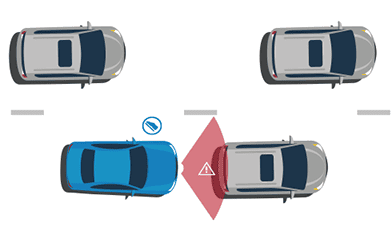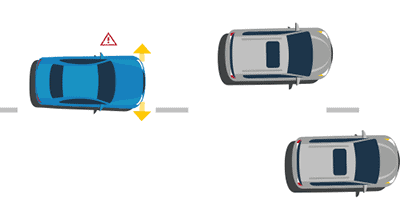The Beginning of ADAS improving accident-reduction odds
By Pam Oakes, MACS Senior Technical Trainer and Curriculum Developer – Published on 10/14/2025
Advanced Driver Assistance Systems (ADAS) are no longer theoretical safety features — they deliver measurable reductions in road accidents according to the Insurance Institute for Highway Safety (IIHS). They attribute ADAS sensor fusion creating platforms like automatic emergency braking (AEB) to blind-spot monitoring is actively preventing crashes and saves lives and property.
In a 2023 report by the IIHS, they published that a vehicle equipped with forward collision warning (Figure 1) and AEB experienced 50-percent fewer front-to-rear collisions compared to those not equipped with the technology. When it came to lane departure warnings (LDW, Figure 2), the technology reduced sideswipe and head-on crashes by 11-percent. And a 23-percent decrease in blind-spot monitoring-lane-change accidents.
A U.S.-based logistics company keeping track of a 1,000-plus fleet equipped with AEB and LDW reported a 34-percent reduction in preventable collisions – especially when it came to rear-collisions in an urban setting. And Tesla’s Autopilot logged a 40-percent decrease in accidents when the system was in its “active” state. ADAS Level 2/Level 3 is making an impact on today’s roads. But ADAS is in its infancy when it comes to Level 5 consumer expectations. Today’s existence within equipped vehicles is beginning to show promise on how to mitigate human error when it comes to automotive accidents. With more ML (machine learning) to (eventual) AI (artificial intelligence), the present-day data gather will allow for even more robust collision avoidance, subsequently saving lives.

Figure 1: Forward collision warning systems can detect a potential collision with a vehicle ahead and provide a warning to the driver. Credit: nhtsa.gov

Figure 2: A lane departure warning system monitors lane markings and alerts the driver when it detects that the vehicle is drifting out of its lane. It’s important to note that a lane departure warning system only provides a warning to the driver and does not take action to avoid a crash. Credit: nhtsa.gov
About the author: Pam Oakes is a Senior Technical Trainer and Curriculum Developer at MACS. Pam provides automotive training at all levels, including train-the-trainer, professional technicians, and scholastic programs, with over 20 years of hands-on experience running a 12-bay shop in Florida. She has been a MACS Section 609 proctor since 2016 with additional expertise including ADAS calibration, fleet training, and technical curriculum development for major corporations. You can reach Pam at poakes@macsmobileairclimate.org.

Learn More
MACS Action Magazine – SEP/OCT 2025 Issue
Questions
Have any questions or comments? Leave a message in the comments below or send us an email! info@macsmobileairclimate.org or call the office at (215) 631-7020.
Leave a Reply